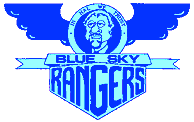Hover Force

INTELLIVISION CARTRIDGE [INTV #8500]
Release 1986
Developed at Mattel Electronics as Hover Force 3-D [Mattel Electronics #7742]
Completed by Realtime Associates for INTV Corporation
Design: Steve Ettinger, Joe [Ferreira] King, David Warhohl
Program: Steve Ettinger
Graphics/Package Illustration: Joe [Ferreira] King
Sound Effects: David Warhol

DEVELOPMENT HISTORY
Hover Force 3-D was developed under greater secrecy than any other Mattel game. Researcher Richard Steenblik working at the University of Georgia had developed pseudo-3-D glasses. Small prisms in the glasses bent different colors of light entering the eye at different angles, fooling the eye into thinking that, for example, blue objects on a flat surface were actually farther away than red objects on the same surface. The University approached several game manufacturers to see if they were interested in the technology. After a middle-of-the-night test session in which Keith Robinson (Solar Sailer) quickly threw together an Intellivision screen full of flying bugs of different colors, Mattel management decided to aggressively pursue an exclusive license for the glasses.
Game development was ordered to start immediately, before the license was secured. For fear that a competitor would find out and try to outbid Mattel, the project was kept top secret, even from the other programmers. It was code named "Peach" since the glasses originated in Georgia, the Peach State. Steve Ettinger and Joe Ferreira, who had worked well together on Magic Carousel, were given a locked, windowless office in which to work (the rest of the software staff worked in open cubicles); it was quickly dubbed "The Bat Cave."
Midway through the project, Mattel won the license and Peach emerged from the cave. The 3-D effect, while not eye-poppingly dramatic, was effective, especially given the visual cues Steve and Joe had designed. And Dave "Papa Intellivision" Chandler's group had developed an inexpensive method to manufacture the glasses, making it practical for the game and glasses to be sold together at the price of a normal cartridge. Marketing felt they could strongly promote the 3-D feature in ads and the press.
Hover Force 3-D debuted at the January 1984 Consumer Electronic Show to good response. While the 3-D effect got mixed reviews, everyone was talking about it. Management immediately started talking about putting two more 3-D games into development, including a flight simulator cartridge, but before anything could be started, Mattel Electronics closed.
For the INTV Corp. release of the game in 1986, Steve and producer Dave Warhol beefed up the "intelligence" of the enemy helicopters, adding more strategy






